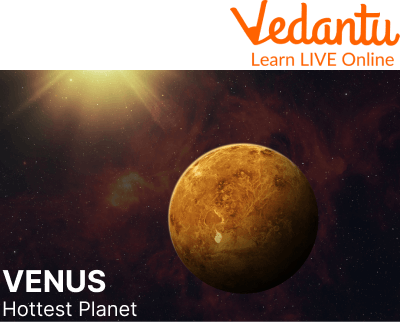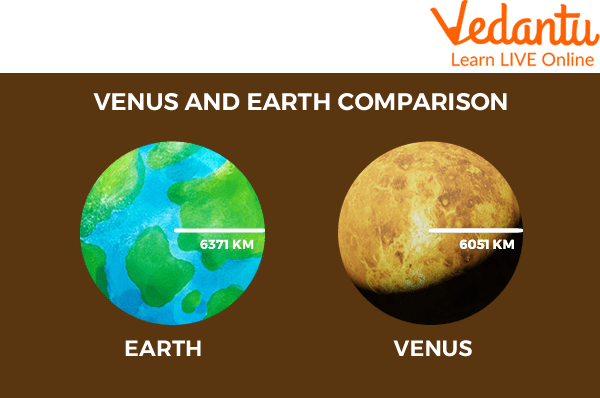




Overview of Venus
Kids, do you know how the planet Venus was named? Venus was named after the ancient Roman goddess of beauty. Venus is known for its extraordinary brightness in the night sky. But behind the facade is a world of storms and infernos, unlike anywhere else in the solar system.
Venus is the second planet from the sun and is very similar to Earth from a distance. But looking closely, it is a very different world. Venus is just slightly smaller. About the same size as Earth, its structure is nearly identical, with an iron core, a hot mantle, and a rocky crust. Let's learn some information about Venus and fun facts about Venus.
The Brightest Planet 'Venus' and Its Information
Venus is the brightest planet and the second planet from the Sun. Let's learn some important information about Venus:
Venus is the sixth-largest and second planet from the sun in our solar system. This planet consists of mountains, valleys, and thousands of volcanoes.
The radius of Venus is 3,760 miles, and a diameter of 7,521 miles, slightly smaller than earth. Because of these similarities with earth in terms of size, structure, and chemical composition, it is often called earth's twin.
The significant difference between the earth and Venus is that Venus rotates on its axis backwards, which is in contrast to most other solar planets.
On Venus, the sun rises in the west and sets in the east, opposite to what happens on Earth.
Venus reflects 70 per cent of all sunlight it receives from the sun, and this is the reason that it is considered the second brightest object in the solar system after the moon and the sun.
Venus' entire surface is covered with clouds made of poisonous sulphur dioxide, giving enough reasons not to step on the planet.
Venus has crushing air pressure at its surface, which is more than 90 times that of earth. This is the pressure you'd encounter a mile below the ocean on earth.

Venus is the Hottest Planet
Interesting Facts About Venus
Now, let's learn some interesting facts about venus:
The crust of Venus is dotted with thousands of volcanoes, including Maxwell Montes, a volcano almost as tall as Mount Everest.
Venus also has a thick layered atmosphere. It has clouds that rain sulphuric acid and covers the planet and move at speeds of up to 224 miles per hour.
The atmosphere is so thick that it creates a surface pressure similar to what would be about half a mile deep in the Earth's ocean, which is 90 times more pressure than the sea level.
The pressure is heavy enough that a human standing on Venus' surface would be crushed. This happens because Venus is the hottest of all other planets.
The atmosphere of Venus is made up primarily of carbon dioxide, a greenhouse gas. This creates an extreme case of global warming. They trap the sun's heat, causing surface temperature to rise over 800 degrees Fahrenheit.
Venus is very inhospitable. Neither humans nor spacecraft can survive on its surface.
Scientists have found abnormal UV radiation about 30 miles above Venus's Clouds, where the surface temperature and pressure are similar to earth. This wonderful event can be evidence of microbial life.
What Does This Brightest Planet Look like?
Now that we have learned many interesting facts about Venus. Let's see how this planet looks with a few amazing pictures taken by the satellites which studied Venus.

Size Comparison of Venus and Earth
Summary
From this article about Venus facts for kids, we have learnt a lot of information about Venus. Venus has a shining appearance in the sky, and microbial life may be supported in the atmosphere of the planet. We might call Venus the planet of love, but landing on its surface is not lovely. After mercury, Venus is the second planet orbiting the sun and is the sixth-largest planet in our solar system. Because of its brilliance, humans have observed Venus for a very long time.
Venus is 45 million miles from earth, yet it is the closest to our planet. A day on Venus is 243 Earth days, and it rotates much more slowly as compared to Earth.
FAQs on Venus Facts for Kids
1. What is the colour of Venus?
Venus has a yellow-white coloured appearance. The planet is entirely covered with a thick carbon dioxide atmosphere and sulphuric acid clouds, which gives it this light yellowish appearance.
2. What are the other names of Venus?
Venus is also called 'the morning star' and 'the evening star.’ Venus is called so because it is the first celestial body to become visible in the evening sky and the last to disappear at sunrise.
3. How many moons are there on Venus?
Venus has no moons. The reason Venus has no moon is its close distance from the sun. Any moon far from Venus would be in an unstable orbit and will be captured by the Sun.
4. How many days are there in one year in Venus?
There are 225 earth days in one year on Venus. Surprisingly, a day on Venus lasts longer than a year.









